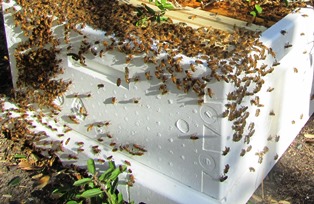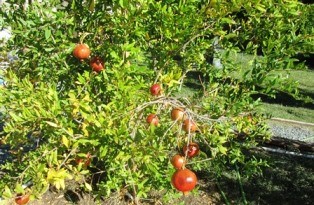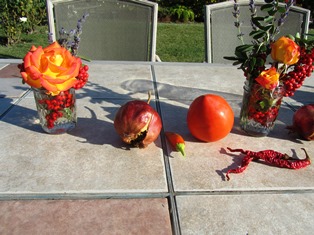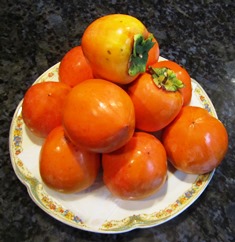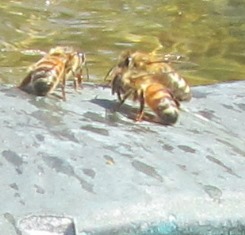Archive for October, 2014
A Dog-Gone Good Day for Rain

Any rainy day is a good day to nap, even if it is Halloween when there might be spooks roaming around
Happy Halloween from the Henny Penny Farmette. It’s raining at last!
The San Francisco Giants, by winning the World Series, must have created Mojo in the Pacific because the storm door has opened. It’s been raining outside my farmette window for a few hours. Could this spell an end to our extreme drought?
It’s been a quiet day for me working on my second book. The two dogs that I’m caring for have shown me the sweetest doggie affection with their wagging tails, smiles (yes, I think they smile), and lots of licks. They’ve won me, the reluctant dog-sitter, over.
We’ll have to say goodbye today though. Their family is enroute from Disneland and will be home in a couple of hours. So while the dogs and I started off on the wrong paw, overall I’d have to say it was a great adventure. I’m gonna miss them.
Try Having a Cup of Tea with These Dogs
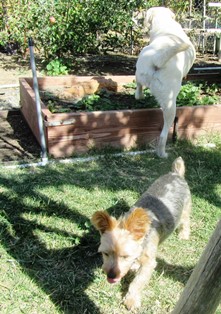
Remington, the white, short-haired lab, is trouncing over the strawberries, while Moose has his sights set on the chickens
I just wanted a nice cup of tea and to sit on the grass and sip it while listening to the birds and watching my bees and chickens. Fat chance. It would take five minutes flat for my daughter’s little dog Moose to knock over the cup, spill the tea all over me, and then traumatize my chickens so badly that their egg-laying is now out of wack; they’re just squatting and dropping.
As a favor to my lovely daughter and her family, I agreed to dog sit on my farmette for four days. My daughter assured me the two family pets would enjoy four days of freedom to romp around our acreage despite one of her dogs being a little high strung. His breed used to chase rats, she said. I didn’t make the correlation. It didn’t seem to matter then.
I reminded her that my bees and chickens both forage freely over the land. The chickens would necessarily have to remain in their chicken run during that period since the dogs might chase them. The bees probably wouldn’t bother the dogs, but I’d take the name of her vet, just in case. Of course, the dogs might not actually like it here.
In retrospect, I believe I underestimated my concerns. Oh, the dogs seem happy enough; it’s my sanity I’m worried about.
The Irish lab named Remington has had some professional training. He is a lovely, well-behaved gentleman. I enjoy him and wish I could same the same for the small dog with the mighty name of Moose who is high-strung, has allergies, and arrived with special gluten-free food, his round bed, and a bag of medications, including a vet-prescribed tranquilizer.
Moose barks a lot. It’s an annoying high-pitched bark. In the yard yesterday, when he wouldn’t stop, I heard my neighbor barking back . . . and that’s just ridiculous!
I thought Moose was going to have a meltdown when he discovered the chickens, barking at the highest decibel he could muster, running the length of the chicken run in one direction with the chickens one step ahead on the inside their poultry-wire pen before hitting the wall where the dog and chickens reversed their direction.
I got half as many eggs yesterday and found two on the ground instead of in the nesting boxes. When the chickens free-range, they always return to the nesting boxes in the hen house to lay their eggs. It’s like they got so scared, they forgot not only where to go but how to properly lay their eggs. I hope things return to normal when the dog visit is over.
I decided to spend the day outside, doing chores like digging planting holes at the front of the property. Moose saw it as a game so as soon as my back was turned, he refilled the holes, pawing like a dog on a mission. I finally gave up on that. The shovel and rake seemed to scare him, so I put those away. And he didn’t like me playing ball with him or the other dog. So we quit on that, too.
By the day’s end though, both dogs seemed tuckered out. Both wanted to sleep in our room. The big dog contented himself in his bed on the floor (by my husband’s side of the bed), but the high-maintenance Moose threw himself onto my pillow, pulled my fleece bathrobe over his head, and nodded off like he owned the place.
When our alarm went off at four o’clock as it does every weekday morning, the yip-yip-yipping and chaos started all over again. Only three more long days and nights left.
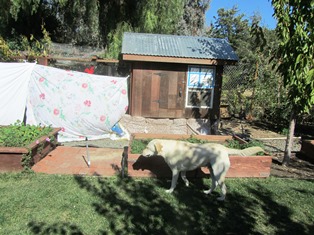
Remi wasn’t the problem but with Moose frightening the chicken feathers off my hens, I draped the chicken run in sheets
I’m going to need a vacation when these four days are over. I just hope my chickens will resume their egg-laying schedule once I take the sheets down off the chicken run (I hung them so Moose couldn’t see the chickens) and I have the energy and some decent weather ahead to re-dig those planting holes. I look forward to having a cup of tea again, too, while I listen to the birds and quiet clucks instead of that shrill yip-yip-yip, amplified by by neighbor’s imitation of it. Ridiculous!
Honeybee Hive Pests Include Real Vampires
Every beekeeper wants to keep his or her hives healthy. Staying on top of your bee’s health means early detection and treatment of pests in the hive such as Varroa mites, trachea mites, hive beetles, and wax moths.
Varroa mites–these small reddish brown pests are akin to tiny vampires, feasting on your bees’ blood. Non-medicinal approaches to treating for these mites include introducing a screened bottom board. Mites fall through and cannot re-enter the hive to reattach to the bees. Also a powdered sugar dusting of your hives’ top bars can dislodge mites.
Tracheal mites–these pests are more difficult to detect. My beekeeper neighbor showed me infant baby bees with partial wings and said he believed it was the work of tracheal mites. To rid your hives of these pests, you’ll need to use menthol crystals and grease patties.
Hive beetles–if you see an insect with a hard, small black shell in corners and dark places within the hive, you may have hive beetles. They devour bee brood, honey, wax, and pollen. Treat the soil in front of the hive and inside the hive, you can try hive beetle traps or treat chemically. The infected honey will be rejected by the bees and should be considered unfit for human consumption as well.
Wax moths–these nasty little creatures can been seen in honeycomb and leave a silky trail over your hive’s hanging frames. If you see evidence that they’ve tunnel into the wood, know that you’ve had the infestation for a while. Wax moths will weaken a colony. Treat the infected hives with moth crystals formulated to eliminate wax moths in the hive.
Hives that are frequently checked their beekeepers stand the best chance for having healthy colonies of bees.
Bumps and Scrapes–Just Part of the Renovation Process
I haven’t had to call on my first-aid skills in a while, but today I lost control of a tree trunk round (that must have weighed close to a hundred pounds). It broke the skin in several places, bruised the flesh, and caused swelling within minutes.

Silly me–if I’d worn boots instead of loafers, my leg would have been protected against cuts and bruises
Luckily, I didn’t break my ankle. This is my comeuppance, I suppose, for going against my architect husband’s admonition not to mess with those rounds regardless of how badly I wanted to keep work moving forward on the farmette landscaping at the front of our house.
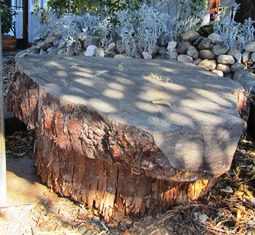
Two- to three-feet wide, these babies are no longer needed in the landscape and can trigger termite infestation when they lie against the soil
The way I see it, it’s only by us tackling something every day that we will ever be able to complete the restoration that this old place needs. I believe it’s been without tender loving care for at least a generation.
Last week, my husband brought in a bobcat and within a few hours had hauled away stone, dirt, and dead stumps. We can now lay paving stones to create a sitting area for outdoor entertaining. The floor he laid at my daughter’s house is pretty and functional. She tells me they love the area and so do their children and friends.

This patio floor that my husband recently laid required several stone shapes and two colors–gray and terra cotta
Out front, we’ve transferred the irises to a raised bed, but the tree that was severely diseased, as well as rocks and wooden stumps, are gone now.
My husband tells me we’re going to get some help with the landscaping work at the front of our property this week. So, in case he warms to the idea of letting me participate, too, I’ll get out my boots, bandana, and straw hat.
You can take the girl off the farm, but you can’t take the farm out of the girl. What can I say . . . I just love digging in the dirt even when it involves the personal risk of bumps and scrapes–isn’t that expected when doing renovation?
*Update on the foot–checked by a doctor and no break. I’ll be drop kicking turnips in no time!
Buying Fair Trade Generates More than Good Taste
We all love our local farmers’ markets where the freshest organic ingredients–direct from the farm to our tables–are easy to find and purchase. And they taste so good. But sometimes, we consumers desire something grown beyond America’s borders, such as tea, coffee, exotic spices, and chocolate. And this is where choice and purchasing power has consequences.
When you choose to buy products displaying a FAIR TRADE certification logo, your action directly and positively impacts the lives of farmers, growers, artisan craftspeople, commodities producers, and their workers in communities in developing nations.
As consumers demand better products and better working conditions for workers, the Fair Trade movement has more clout to lobby on behalf of commodity farmers, impoverished workers, and child laborers.
If you love chocolate, consider this: seventy percent of the world’s cocoa beans is produced in Cote d’Ivoire and other Western African countries. Pay is nominal at $2 USD/per dieum and, according to UNICEF, more than a half million children labor under dire working conditions in the cocoa fields in these bean-producing countries even though child labor is illegal in the cocoa industry.
Coffee was one of the first Fair Trade certified products but today’s consumers can now also find Fair Trade certified cocoa, wine, cotton, fruit, tea, red palm oil, coconut oil and associated products, chocolate, honey, quinoa and other ancient grains, beans, sugar, and bananas, to name a few items.
The Fair Trade Movement has been around since mid last century. It began as a mainly North American/European social movement to aid poor farmers, commodity producers, and laborers in developing nations to achieve more favorable trading conditions. Fair Trade also promotes sustainability.
Choosing to buy a product carrying the Fair Trade certification label means your consumer decision will impact more than your taste buds–it will have positive ramifications for workers, commodity producers, and their communities beyond America’s borders.
How to Repay the Thoughtful Gift of a Truckload of Manure
I begin obsessing about soil and manure this time of year after the summer garden is gone. The old adage of: take care of the soil and it will take care of you (via your plants) is really true. Out here on the farmette, the clay soil is so heavy that it cracks open in fissures during summer, so we are always working to improve it.
Recently, a generous friend brought us a truckload of horse manure. It was no small truck either. The manure seemed mostly aged and I could easily rake it into our flower beds and little lawn. Some of though is still relatively green, not aged, and I worry about using it to grow my winter crop of vegetables for fear of E-coli contamination.
There’s a new area where we are debating or not to put down a stone floor and just grow trees and flowers in a container wall on two sides. It might be the perfect place to use some of that horse dung.
In the meantime, on the property behind ours, the horse manure has been spread out with a bobcat to keep the growing areas fertile for the trees that were planted there nearly four or five decades ago.
There are all kinds of manures one can use in the garden, from bat guano and worm casings to animal waste products–horse, cow, sheep, steer, turkey, rabbit, and chicken, for example.
You can get manure tested, much like you can soil, to detect levels of nitrogen, phosphorus, and potassium. Not all manures are high in nitrogen, which is loved by many gardeners for that sudden growth and burst of bloom. Some manures, like cow and horse, also can carry seeds of weeds or whatever the animal has grazed on, which can emerge in your garden.
Most manures can be made into a fertilizer “tea” by mixing with water. Whether you apply aged manure or manure tea, always wash your fruits and vegetables well before eating to reduce the risk of consuming contaminated fruit or produce.
We appreciate our friend’s gift. Now . . . we wonder how to repay his kindness. I’m thinking a basket of persimmons and pomegranates, a French sugar pumpkin, a dozen organic eggs, and jars of jam and honey.
Traits of Common Honeybee Strains
There are four main strains of domestic honeybees: Italian, Carniolan, Caucasian, and German Black. The bees in my backyard hives are of the Italian variety. They are gentle and co-exist with my chickens as well as tolerate visits from my daughter’s dogs who drop by to sniff around.
Italian, apis mellifera linguistica.
- Their coloring includes yellow pigmentation; the only honeybee with this coloring.
- They are gentle
- They don’t go great distances to forage
- They tend to produce honey stores in late summer and continuing foraging until late in the autumn to produce enough honey to get through the lean winter months
- They are not considered frequent swarmers
- They have a moderate spring buildup of the hive
- They may drift somewhat
Carniolan–apis mellifera carnica are honeybees that evolved on the European continent, particularly around Slovenia, Austria, Croatia, Serbia, Bosnia and Herzegovina.
- Carniolan honeybees are big and long in size like the Western European black bee.
- They possess a long tongue and high elbow joint
- They have pigmented dark spots in brown or gray and also have gray hairs
- They rapidly build up their numbers in the spring
- They are calm and gentle, not aggressive
- They swarm heavily
- They forage even under less than ideal conditions
- They may drift
Caucasian–-apis mellifera caucasica emerged in the Black Sea Caucus mountains and can be found today in Georgia, Turkey, Armenia, and Azerbaijan.
- Their color is mostly dark with some gray or brown spotting.
- They are gentle
- Slowly build their numbers in the spring
- Swarm less
- They produce lots of propolis (baby bee food)
- They tend to stop foraging and making honey stores early in the fall
- They winter over well except in northern climates where Nosema can be a problem
- They have a tendency to drift
German Black—apis mellifera mellifera was the first bee in America and still is prominent in feral populations but they are native to England and Germany.
- Their size is small
- Their pigmentation is dark
- They are not noted for gentleness
- They are susceptible to American foulbrood (AFB), one of the most dreaded diseases to affect honeybees
- They have survived in areas invaded by the aggressive Africanized bees
- They are well suited to northern climates
 Facebook
Facebook Goodreads
Goodreads LinkedIn
LinkedIn Meera Lester
Meera Lester Twitter
Twitter





